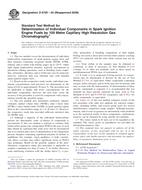We need your consent to use the individual data so that you can see information about your interests, among other things. Click "OK" to give your consent.
ASTM D7096-10
Standard Test Method for Determination of the Boiling Range Distribution of Gasoline by Wide-Bore Capillary Gas Chromatography
STANDARD published on 15.2.2010
The information about the standard:
Designation standards: ASTM D7096-10
Note: WITHDRAWN
Publication date standards: 15.2.2010
SKU: NS-37532
The number of pages: 15
Approximate weight : 45 g (0.10 lbs)
Country: American technical standard
Category: Technical standards ASTM
The category - similar standards:
Annotation of standard text ASTM D7096-10 :
Keywords:
blending streams, boiling range distribution, capillary gas chromatography, gas chromatography, gasoline, oxygenate, Boiling range distribution, Gas chromatography (GC), Gasoline, Simulated distillation, ICS Number Code 75.160.20 (Liquid fuels)
Additional information
| Significance and Use | ||||||||||||||||||||||||||
|
The determination of the boiling range distribution of gasoline by gas chromatographic simulated distillation provides an insight into the composition of the components from which the gasoline has been blended. Knowledge of the boiling range distribution of gasoline blending components is useful for the control of refinery processes and for the blending of finished gasoline. The determination of the boiling range distribution of light hydrocarbon mixtures by gas chromatographic simulated distillation has better precision than the conventional distillation by Test Method D86. Additionally, this test method provides more accurate and detailed information about the composition of the light ends. The distillation data produced by this test method are similar to that which would be obtained from a cryogenic, true boiling point (15 theoretical plates) distillation. This test method is intended to expand upon Test Method D3710 by defining mandatory response factors, use of capillary column technology, inclusion of oxygenates, and use of flame ionization detection. |
||||||||||||||||||||||||||
| 1. Scope | ||||||||||||||||||||||||||
|
1.1 This test method covers the determination of the boiling range distribution of gasoline and liquid gasoline blending components. It is applicable to petroleum products and fractions with a final boiling point of 280°C (536°F) or lower, as measured by this test method. 1.2 This test method is designed to measure the entire boiling range of gasoline and gasoline components with either high or low vapor pressure and is commonly referred to as Simulated Distillation (SimDis) by gas chromatographers. 1.3 This test method has been validated for gasoline containing ethanol. Gasolines containing other oxygenates are not specifically excluded, but they were not used in the development of this test method. 1.4 This test method can estimate the concentration of n-pentane and lighter saturated hydrocarbons in gasoline. 1.5 The values stated in SI units are to be regarded as standard. No other units of measurement are included in this standard. 1.5.1 Results in degrees Fahrenheit can be obtained by simply substituting Fahrenheit boiling points in the calculation of the boiling point-retention time correlation. 1.6 This standard does not purport to address all of the safety concerns, if any, associated with its use. It is the responsibility of the user of this standard to establish appropriate safety and health practices and determine the applicability of regulatory limitations prior to use. |
||||||||||||||||||||||||||
| 2. Referenced Documents | ||||||||||||||||||||||||||
|
Similar standards:
Historical
1.6.2011
Historical
1.7.2010
Historical
1.5.2013
Historical
1.10.2011
Historical
15.4.2009
Historical
1.5.2011
We recommend:
Technical standards updating
Do you want to make sure you use only the valid technical standards?
We can offer you a solution which will provide you a monthly overview concerning the updating of standards which you use.
Would you like to know more? Look at this page.



 ASTM D6379-11
ASTM D6379-11 ASTM D6424-04a(2010)..
ASTM D6424-04a(2010).. ASTM D6584-13e1
ASTM D6584-13e1 ASTM D6728-11
ASTM D6728-11 ASTM D6729-04(2009)..
ASTM D6729-04(2009).. ASTM D6730-01(2011)..
ASTM D6730-01(2011)..
 Cookies
Cookies
